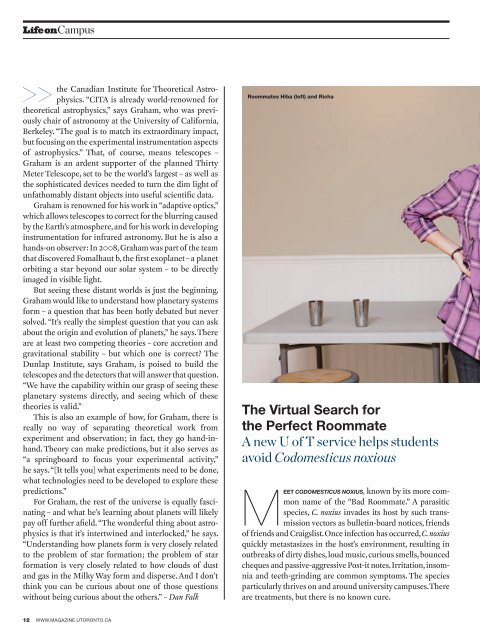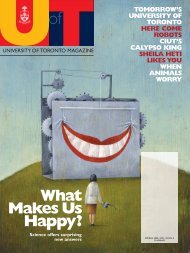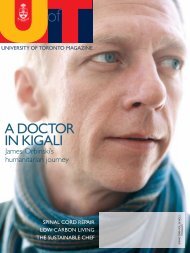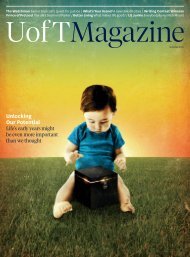The Next Big Idea 10 concepts that could - University of Toronto ...
The Next Big Idea 10 concepts that could - University of Toronto ...
The Next Big Idea 10 concepts that could - University of Toronto ...
Create successful ePaper yourself
Turn your PDF publications into a flip-book with our unique Google optimized e-Paper software.
LifeonCampus<br />
the Canadian Institute for <strong>The</strong>oretical Astrophysics.<br />
“CITA is already world-renowned for<br />
theoretical astrophysics,” says Graham, who was previously<br />
chair <strong>of</strong> astronomy at the <strong>University</strong> <strong>of</strong> California,<br />
Berkeley. “<strong>The</strong> goal is to match its extraordinary impact,<br />
but focusing on the experimental instrumentation aspects<br />
<strong>of</strong> astrophysics.” That, <strong>of</strong> course, means telescopes –<br />
Graham is an ardent supporter <strong>of</strong> the planned Thirty<br />
Meter Telescope, set to be the world’s largest – as well as<br />
the sophisticated devices needed to turn the dim light <strong>of</strong><br />
unfathomably distant objects into useful scientific data.<br />
Graham is renowned for his work in “adaptive optics,”<br />
which allows telescopes to correct for the blurring caused<br />
by the Earth’s atmosphere, and for his work in developing<br />
instrumentation for infrared astronomy. But he is also a<br />
hands-on observer: In 2008, Graham was part <strong>of</strong> the team<br />
<strong>that</strong> discovered Fomalhaut b, the first exoplanet – a planet<br />
orbiting a star beyond our solar system – to be directly<br />
imaged in visible light.<br />
But seeing these distant worlds is just the beginning.<br />
Graham would like to understand how planetary systems<br />
form – a question <strong>that</strong> has been hotly debated but never<br />
solved. “It’s really the simplest question <strong>that</strong> you can ask<br />
about the origin and evolution <strong>of</strong> planets,” he says. <strong>The</strong>re<br />
are at least two competing theories – core accretion and<br />
gravitational stability – but which one is correct <strong>The</strong><br />
Dunlap Institute, says Graham, is poised to build the<br />
telescopes and the detectors <strong>that</strong> will answer <strong>that</strong> question.<br />
“We have the capability within our grasp <strong>of</strong> seeing these<br />
planetary systems directly, and seeing which <strong>of</strong> these<br />
theories is valid.”<br />
This is also an example <strong>of</strong> how, for Graham, there is<br />
really no way <strong>of</strong> separating theoretical work from<br />
experiment and observation; in fact, they go hand-inhand.<br />
<strong>The</strong>ory can make predictions, but it also serves as<br />
“a springboard to focus your experimental activity,”<br />
he says. “[It tells you] what experiments need to be done,<br />
what technologies need to be developed to explore these<br />
predictions.”<br />
For Graham, the rest <strong>of</strong> the universe is equally fascinating<br />
– and what he’s learning about planets will likely<br />
pay <strong>of</strong>f further afield. “<strong>The</strong> wonderful thing about astrophysics<br />
is <strong>that</strong> it’s intertwined and interlocked,” he says.<br />
“Understanding how planets form is very closely related<br />
to the problem <strong>of</strong> star formation; the problem <strong>of</strong> star<br />
formation is very closely related to how clouds <strong>of</strong> dust<br />
and gas in the Milky Way form and disperse. And I don’t<br />
think you can be curious about one <strong>of</strong> those questions<br />
without being curious about the others.” – Dan Falk<br />
Roommates Hiba (left) and Richa<br />
<strong>The</strong> Virtual Search for<br />
the Perfect Roommate<br />
A new U <strong>of</strong> T service helps students<br />
avoid Codomesticus noxious<br />
Meet Codomesticus noxius, known by its more common<br />
name <strong>of</strong> the “Bad Roommate.” A parasitic<br />
species, C. noxius invades its host by such transmission<br />
vectors as bulletin-board notices, friends<br />
<strong>of</strong> friends and Craigslist. Once infection has occurred, C. noxius<br />
quickly metastasizes in the host’s environment, resulting in<br />
outbreaks <strong>of</strong> dirty dishes, loud music, curious smells, bounced<br />
cheques and passive-aggressive Post-it notes. Irritation, insomnia<br />
and teeth-grinding are common symptoms. <strong>The</strong> species<br />
particularly thrives on and around university campuses. <strong>The</strong>re<br />
are treatments, but there is no known cure.<br />
12 WWW.MAGAZINE.UTORONTO.CA
















